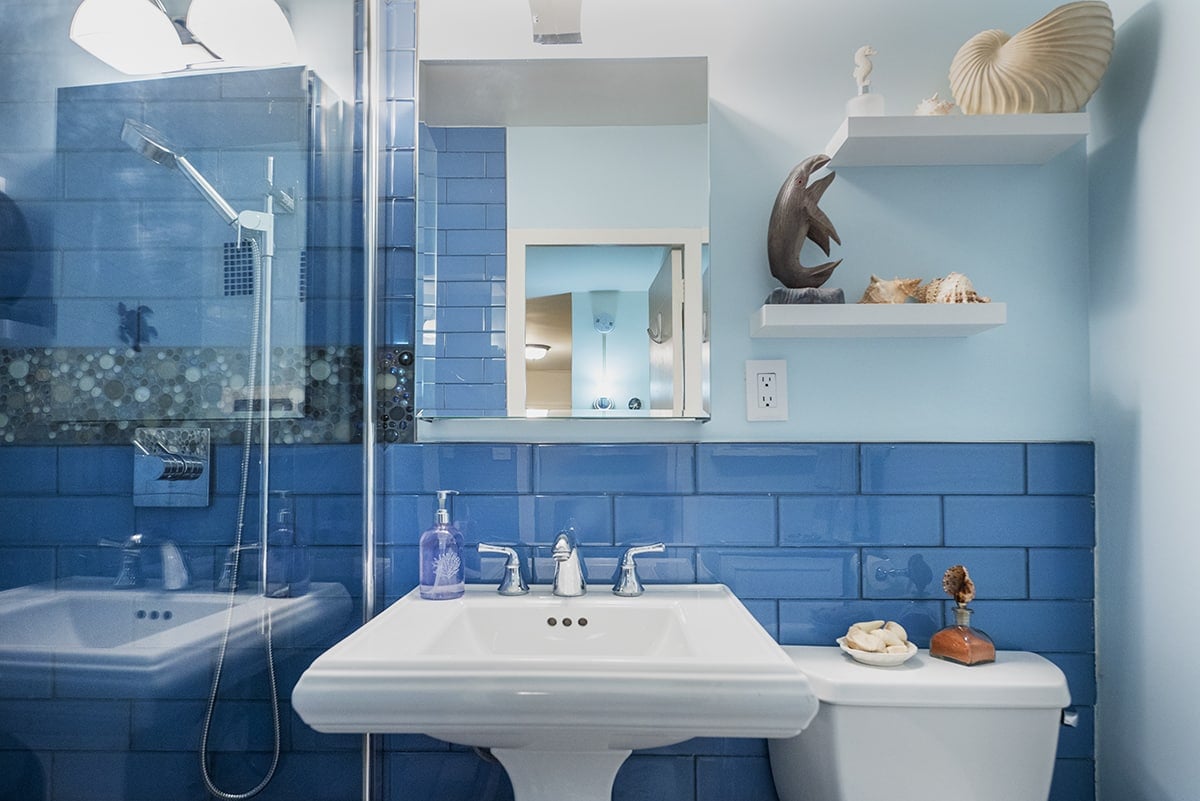NYC Bathroom Tile
Bathroom Tile
A bathroom’s wall covering is subject to the same moisture and heat as its flooring, which is why products like wall paper are usually not a good idea. By far the most popular and practical bathroom wall covering is ceramic, stone, glass or metal tile. If you decide to use tile for the walls, you can achieve a nice effect by using the same color tile for the floor and walls, selecting tiles in the same color family, or pairing stone and metal or glass and ceramic.
Tile For Bathroom Walls & Floors
Tile—for flooring and walls—is by far the most popular and practical design technique for today’s modern bathrooms and kitchens because it doesn’t buckle or warp from constant moisture and is remarkably easy to clean. From the artistry of handcrafted ceramic to the natural beauty of stone, there’s a tile for every design imaginable. You can even select leather tiles, or for those who are looking to green their homes, recycled tiles. Consider combining stone and metal tiles or glass and ceramic for a look at once unique and functional.
Types of Bathroom Tiles
Ceramic and Porcelain Tiles
Most bathrooms are tiled with ceramic. Some colors, textures and styles can only be manufactured using ceramic tile technology. The most popular type is the glazed ceramic tile. This has a ceramic base with a very shiny coat of glaze on top. One of the most popular styles is the subway tile. This 3″ x 6″ or 4″ x 8″ tile usually is installed in a brick pattern. The biggest advantage of ceramic tile design is that it’s maintenance free. It is not porous, can be easily cleaned and comes in a variety of colors and styles. The disadvantage is that wear and tear may crack or chip the top glaze. This will create a visible mark because the base is a different color than the glaze coat. Extremely durable, porcelain is made of the same material from top to bottom. Even if the top chips or scratches, the mark is not visible. Porcelain tiles that imitate real stone are very popular. Since tiles vary slightly in shade and texture, it is difficult to tell porcelain from real stone. In addition, porcelain is priced very competitively. Durability, attractive appearance and great pricing make porcelain one of the most widely used tiles today.
Glass Tiles
This has become a big trend in recent years. At one time, it was extremely expensive but now is much more affordable. Glass tile can be used as a border or used to create beautiful mosaics in a great variety of colors and custom blends. The beauty of glass tile is unique because the glass reflects the light, which highlights every tile. Installing glass tile requires a higher level of expertise and some special materials but if you like the look, it’s worth it.
Jerusalem Stone Tiles
Of all natural stone tiles, this is the most popular option. It comes it a variety of gray, cream and beige tones. Jerusalem Gold tile may be mixed with other stone, metal or glass tiles as borders or accents. Jerusalem Gold mosaics are the best-selling natural stone tiles in the New York market. Despite the fact that Jerusalem stone is porous and relatively expensive, it is a very appealing option.
Stone Tiles
Nothing says sophistication and luxury like natural stone tiles. Materials like limestone, marble, granite, travertine and slate all make a distinct impact on your overall design. Marble’s unique veins make it a sophisticated and beautiful tile for luxury bathrooms and kitchens. Stone tiles come from different regions and quarries have different colors and veining so that the stone tile you install in your home—whether its Brazilian Granite or Italian Marble—are entirely unique. Some stone, like marble, is porous and therefore prone to staining. Because of this propensity for staining, it requires more maintenance than other stones like granite and must be polished every few years or so.
Metal Tiles
Metal tiles, when combined with ceramic, stone or glass, add a unique and stunning look to your bathroom or kitchen design. These pieces are usually more expensive than other types of tiles, and so are used as accent pieces in combination with other less expensive tiles.
Marble Tiles
With its veins and texture, marble is unparalleled by any other stone. The popularity of marble, however, has decreased significantly over the years. The disadvantage is that marble is porous and can stain. It also requires more maintenance than any other tile and must be polished every few years.
Recycled Leather Tiles
Recycled leather tiles offer an interesting texture and a look of sumptuousness. Because they don’t stand up well to moisture, they’re fine for kitchens but best used in a half bath or bathroom without a tub or shower. But they do offer an unusual feel that will add a layer of beauty and sophistication to any home. And because they’re recycled, you can rest assured that you’ve chosen a green product for your home.
Concrete Tiles
Concrete tile is just about impervious to damage, resistant to steam and moisture, and offers an industrial look perfect for urban design. And because concrete is such a versatile material, concrete tiles come in an endless variety of textures and shapes. Pairing a smooth concrete floor tile with a textured concrete wall tile—or even a poured concrete countertop can add drama and contrast to your bathroom or kitchen.



